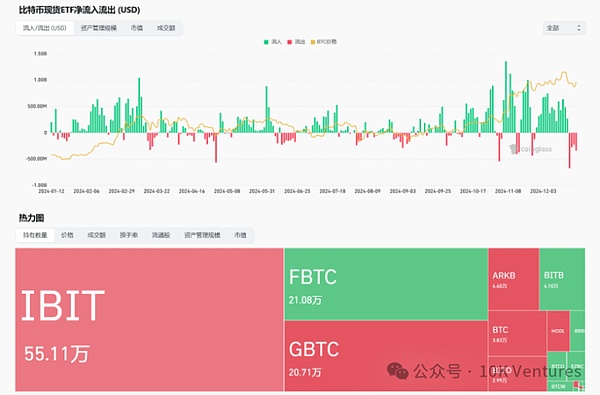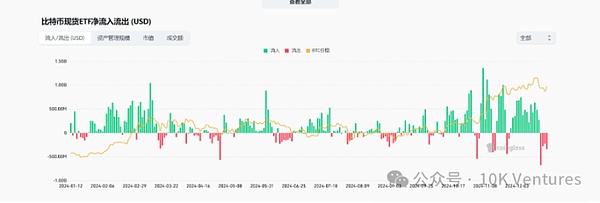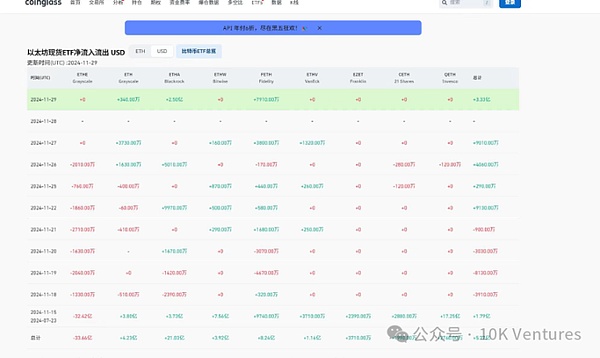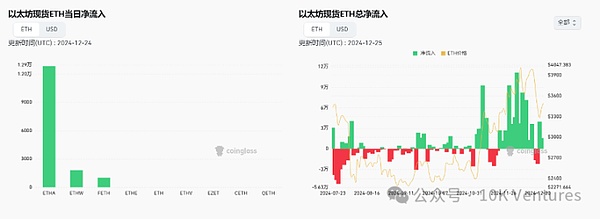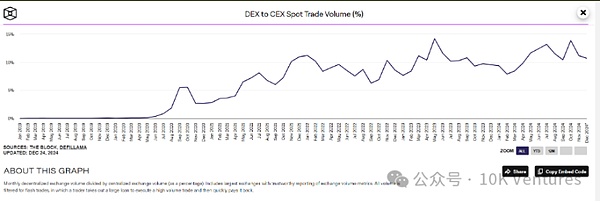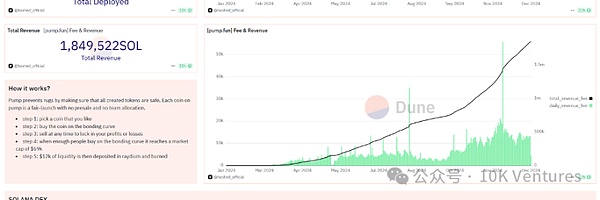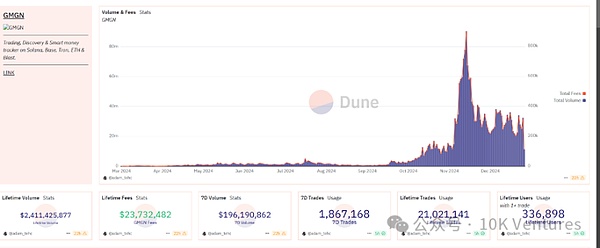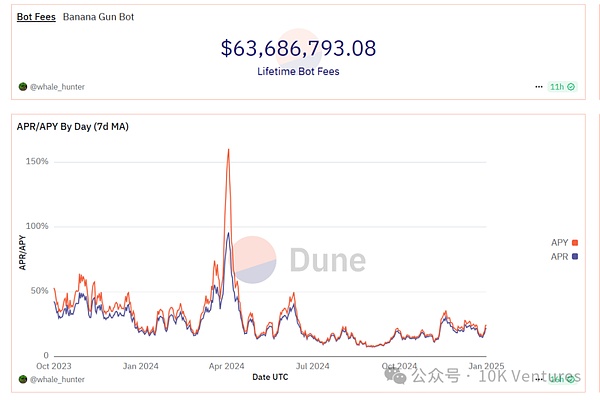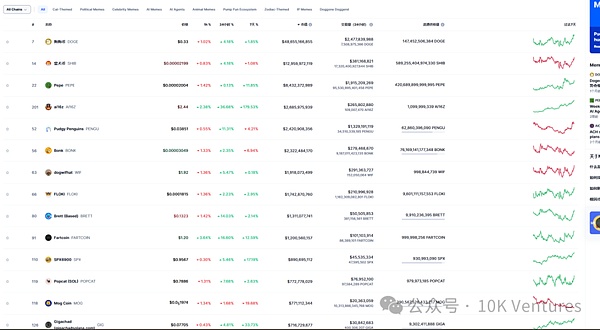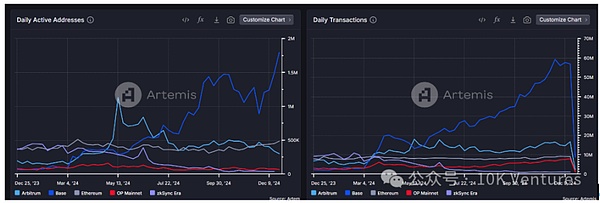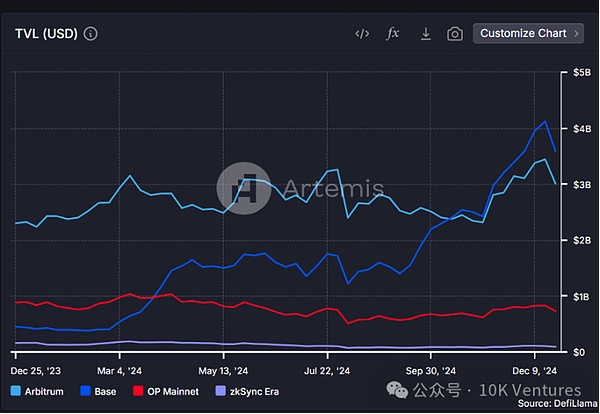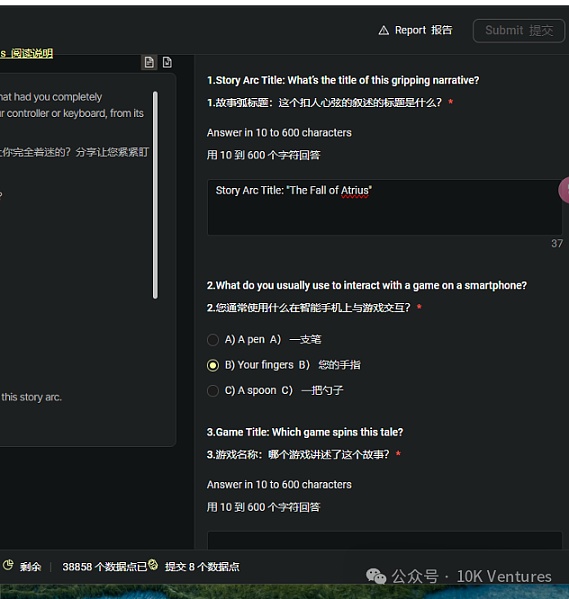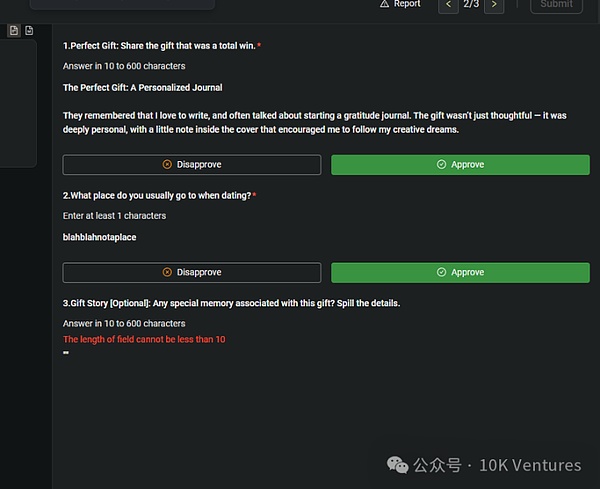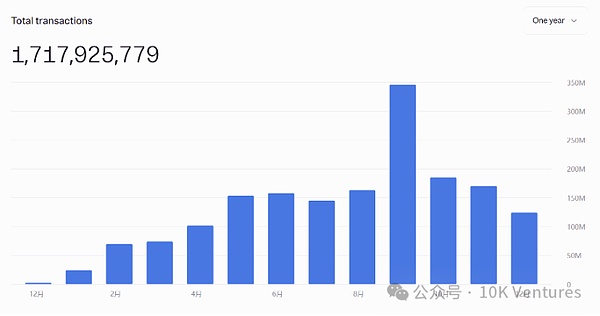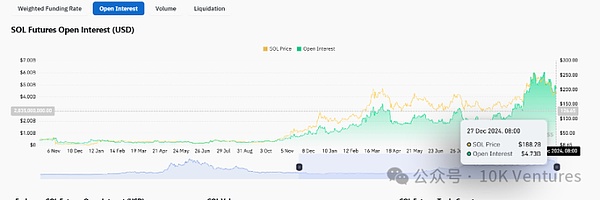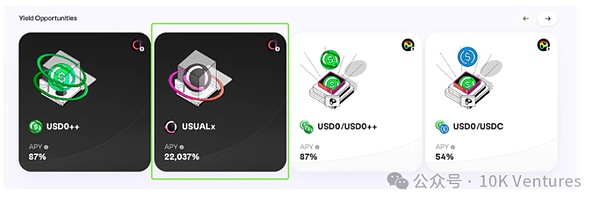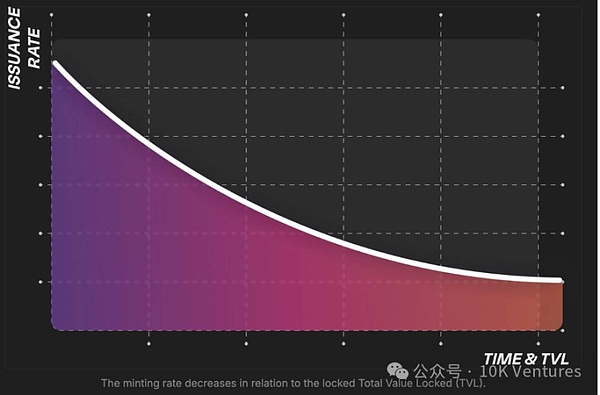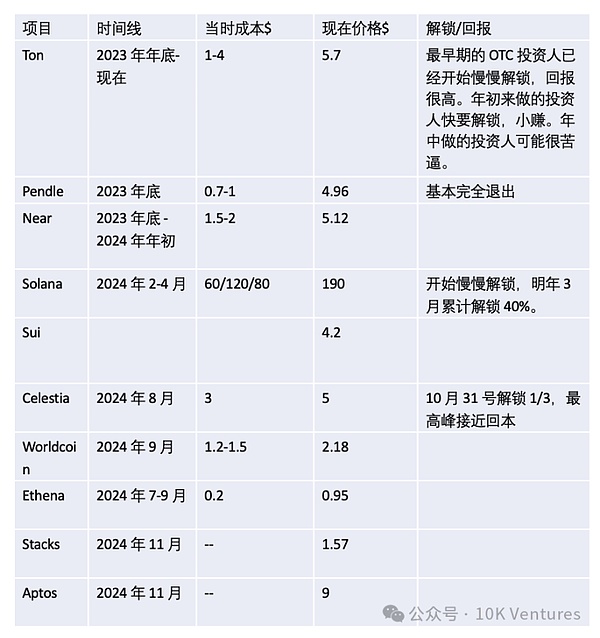Written by: 10K Team
The annual report is divided into two parts
This part shares our thoughts on 2024
This part mainly covers the following aspects of 2024:
(1) The impact of ETFs
(2) DEX vs CEX
(3) Application chains
(4) Stable vs on-chain asset management
(5) Has the industry entered a PE moment?
01. ETFs and giants dominate the market
1.1 BTC ETF has seen a significant net inflow in a year, and pricing power has shifted to North American institutional investors
After the launch of BTC ETF this year, North American BTC ETFs have started to increase their holdings on a large scale. As of December 25, North American ETFs hold about 1.19 million BTC, accounting for 5.66% of all BTC. When they were just launched, they held less than 670,000 BTC, a significant increase of 525,600 BTC in a year.
Observing the net inflow and outflow of BTC ETFs, we can find that the fluctuations of BTC this year are highly positively correlated with the net inflow and outflow of ETFs, and the pricing power is gradually shifting to North America.
This trend is further strengthened by the following factors: large CEXs have become more selective towards VC-backed teams (and also charge high listing fees from teams), while on-chain liquidity is growing with the development of better tools (such as CLOBs, launchpads, Moonshot and other front-end tools).
1.2 The progress of ETH ETF is relatively slow, and it is currently in the stage of intra-circle to extra-circle hand-over
Overall, the net inflow progress of ETH ETF is relatively slower than that of BTC ETF. November 29 this year was a turning point, when ETH ETF started to see a significant net inflow, with a net inflow of $300 million on that day, twice the cumulative net inflow of the previous 4 months. Since then, ETH ETF has continued to see net inflows, but we have also observed that some crypto native old OGs like Justin Sun have started to sell Ethereum, and the current trend is that the intra-circle is selling and the extra-circle ETFs are increasing their holdings. As of December 26, ETFs cumulatively hold 3% of ETH.
We believe that ETH will also gradually change hands, with the pricing power shifting from crypto natives to North America, but this hand-over process may be relatively longer than BTC. If ETH can have new narratives from institutions next year, such as ETH ETF being able to generate staking yields and not being considered a security, then that would be positive.
02. DEX Flip CEX?
2.1 The ceiling of on-chain spot trading may be gradually approaching its limit
From the beginning of 2024, we can clearly see that the market share of on-chain spot/derivatives is constantly expanding in the new 4-year cycle.
But the dex/cex trading volume may have a certain ceiling. This is because the large trading volume in the blockchain world still comes from mainstream coins like BTC/ETH/SOL/XRP, and the trading volume and best trading depth of these mainstream coins are still in CEXs. But as the answer to "why crypto" - the biggest use of crypto is to use tokens to incentivize mid-to-long-tail users/project parties. The recent large on-chain trading volume has been in meme coins, which are mid-to-long-tail project parties compared to mainstream coins.
If BTC/ETH and other mainstream coins remain the market hotspot in the future (which is highly likely), and meme coins do not occupy the majority of the trading volume, then the ceiling of on-chain spot trading may be seen soon. Or we can say that meme coins are eating up the trading volume of mid-to-tail VC coins on CEXs.
In terms of the market share of on-chain DEXs, thanks to the emergence of Pumpfun, Raydium's market share has grown tremendously, once accounting for 28% of the total on-chain DEX market share. Due to the relatively sluggish performance of the Ethereum ecosystem this year, Uni's market share has dropped from 42% at the beginning of the year to 33%. The biggest dark horse this year is Aerodrome, which has grown from 0% market share at the beginning of the year to 10% now, thanks to the active Base ecosystem, becoming the leader on Base (Long Aero=Long Base).
2.2 Hyperliquid stands out
Due to the relatively small market size of the original on-chain derivatives sector, Hyperliquid's surge in November has led to a significant increase in the dex/cex futures trading volume, with its market share rising from 4% to 8% on its own.
We often say that the competitive features of perp dex are:
1. Institutions prefer Orderbook, while retail/whales prefer Pool model
2. The trading volume of market makers/takers is greater than that of retail
3. In the Orderbook model, MM/Taker brings trading volume and liquidity from 0 to 1, while the "gameplay" (airdrop + pump) brings 1 to 10 for retail
4. Although the threshold for Pool is low, the gross profit of MM is also low; the threshold for Orderbook is high, but the gross profit of MM is also high
GMX/Jupiter, representing the LP Pool model, represents the dydx derivatives 1.0 model. GMX/Jupiter allows retail to add liquidity pools to bet against traders, on the one hand earning trading fees, and on the other hand earning liquidation fees, decentralizing the commercial model of CEX MM to retail investors, creating a new paradigm for on-chain perp dex.
But after the bear-bull transition, institutions have rushed in again, and liquidity has become abundant again. The trading depth and profit margin represented by the Pool model can no longer meet the needs of institutions, and the derivatives trading sector has returned to the 3.0 Orderbook model. One might think that building a high-performance derivatives trading platform is simple, but in reality it is not. Simply buying a trash trading engine from Chainup cannot meet the needs of high-performance trading. Hyperliquid has spent two years building its own trading engine, telling the story of an L1, using the Orderbook model to match trades, and using HLP to attract retail to add liquidity. Hyper is currently the perfect culmination of perp dex.
At the same time, we believe that perp dex still has room for improvement, and the improvement may be in the area of licensing - top market makers still tend to MM in compliant/guaranteed perp dex.
3. Solana/Base/Ton - A Battle of Champions
3.1 Pump.fun single-handedly contributes half of Solana's trading volume
Whenever we ask the top Infra/public chain companies what kind of ecosystem they want to build, we have always held that if a true Infra/public chain company wants to stand out, it must have a unique project/track within its ecosystem.
DeFi/Ethereum, Stepn/Solana+BSC, GameFi/BSC, DePIN/Solana, Payment/TRON. This time, Pump, as the leading dapp, has once again saved the Solana ecosystem, generating $300 million in revenue this year. Solana's Payfi and DePIN stories appeal to traditional investors, who are willing to buy in. But retail may not recognize Payfi and DePIN, after all, APYs of a few percent on a money market fund, supply chain finance, wifi base stations, and map data collection are still too far from the pure gambling retail investors, who prefer the excitement of a big green/red candle that releases dopamine. In addition, Pumpfun's website design is very addictive, with the flashing lights and pop-ups able to 200% amplify the greed in the hearts of users, pure gambling, the ultimate enjoyment.
The development path of Solana is now very clear.
On the B2B side, the Foundation is telling the story of being able to serve Web2 enterprise customers, such as Payfi, after all, cross-border payments/payfi are currently happening bottom-up in the enterprise sector. The promotion of DePIN to enterprises has not been as sexy, and it has been found that the promotion speed of DePIN is not as fast as expected. After all, in such an efficient on-chain world, it requires a real industrial chain + supply chain + global distribution to form a certain scale before it can serve the B2B sector, and the speed will not be too fast.
On the B2C side, there is nothing better than a low-threshold casino + lottery to make money.
Here is the English translation of the text, with the terms in <> retained as is:In addition, I would like to add a point about the auxiliary trading tools of the "brokerage" products of the GMGN category. As the leading product in the track, it has earned over $20 million in revenue in the last 3 months. This provides a new entrepreneurial idea for web2 product managers entering the crypto space. Compared to the products seen in the previous cycle, such as Dune and Tokenterminal, the commercialization capability is at least two orders of magnitude stronger, thanks to these auxiliary trading products directly entering the trading.
We will also continue to observe similar product equity investment opportunities and revenue sharing. The financing model of such products is often equity financing + revenue sharing, but based on our observation, this investment model is not very cost-effective for investors (it's actually quite good to do it yourself). Usually, the first-round valuation is 10-20m, with investors holding around 20% of the shares, which means that to break even through dividends, the company must generate revenue of 10-20m over its lifetime, which is very challenging, given the dominant network effect in blockchain and the typically short life cycle.
3.2 Solana Memecoin - One Triumph, Thousands Perish
The most successful theme this year has undoubtedly been Meme coins. A significant portion of the trading volume of Meme coins has siphoned off the trading volume of mid-tier and long-tail VC coins. The pump.fun event in October-November 2022 pushed the Meme coin frenzy to its peak, with dozens of new projects launching every 10 seconds globally. This year, Meme coins such as ai16z, bonk, bome, and spx6900 have reached a circulating market cap of over $1 billion.
The Meme market offers tremendous price swings, with intraday volatility reaching thousands of times, but the high returns come with high risks, and many Meme coins can instantly go to zero.
The data shows that 99% of Meme coins are unable to break through the 1M market cap. The Meme coins that manage to break out of the tens of thousands are truly "one triumph, thousands perish".
3.3 AI Agent Leads the Rise of Base
In our October monthly report, we had highlighted the rise of the Base ecosystem. Two months later, Base is now significantly ahead of other Ethereum ecosystems in terms of both DAU and TVL.
In the current Base ecosystem, Virtual and Clanker are the most likely representative projects besides Aerodrome. Virtual is core product-driven, emphasizing the connection between AI and Web2 users, gradually building a system of "usable" tools. Google's former CEO Eric Schmidt and Marc Andreessen have pointed out the unique advantages of the Virtual team in high-frequency trial and error. From PathDAO to Virtual Protocol, the team has achieved the miracle of growing the market cap from $10 million to $3 billion in three years, spanning GameFi, AI+DApp. In addition to the practicality of the AI Agent itself (e.g., Luna can interact with users), since Virtual has issued its Token, the gameplay will be more diverse than pump.fun. Using Virtual to participate in new token launches, etc., replicating the pump.fun/sol approach.
Interestingly, many projects this year have had more or less innovation in Tokenomics, truly realizing the flywheel effect of business + token.
3.4 What is Ton's Breakthrough Point Besides Tap2Earn?
We had previously issued a research report on Ton in the middle of this year, in which we were not particularly Bullish on the Ton ecosystem. The main reason is that we are not optimistic about the user acquisition model under the Tap2Earn system. Tap2Earn is different from the paid system in DePIN and GameFi projects. The story told by DePIN projects is that when there are more long-tail suppliers, the demand side will pay for the entire long-tail supplier and ecosystem, such as Render rendering and Mobile communication. The story told by GameFi is that the game is fun, and users will pay for the platform and gold farmers due to entertainment needs.
But the story of Tap2Earn is that when I have enough users, there will be advertising business value. But the problem is that these Tap2Earn users are pure wool party, with very low commercial value, or the existing commercial value is just being sold to the exchange in one shot. After half a year, we believe that the Tap2Earn user acquisition + advertising business model is difficult to sustain in the long run. Rather than saying Tap2Earn is a business innovation, it is more accurate to say that the new round of blockchain user acquisition mission has been completed by hamsters/catizens/DOGE a few months ago.
So where will Ton's next breakthrough point be? For example, we have recently seen the alpha test data labeling product of Sahara, which is mainly for long-text. If a company can obtain actual orders and distribute them through Telegram for users to do the labeling, it may be a very "sexy" "web3 data Foxconn". But such companies need to seriously consider the quality issues after crowdsourcing distribution.
In addition, after detailed communication with friends from the Ton Foundation, we have also deeply realized the problem of the Ton ecosystem - ecosystem projects often see token issuance as a short-term opportunity, with conspiracy groups issuing a wave of tokens and then moving on to the next project, such as DOGE/Hamster. Exchanges have obtained the new users of these projects, and that's all they want. The past six months have proven that these users will not bring too much value to the exchanges, nor will they bring higher TX to Ton (after all, they withdraw after finishing the wool collection, and the on-chain penetration rate is too low). The Telegram team is basically indifferent to the token price and is in a state of Buddhism. Therefore, we remain cautious about the subsequent opportunities of Ton.
4. Stable ❌ On-Chain Asset Management ☑️
Stablecoin company revenue = AUM * Interest Rate.
The underlying interest rate of the stablecoin industry is usually pegged to government bonds. The new on-chain stablecoins that have emerged this cycle are mainly USDE and USD0. There are two approaches - one is to grow the AUM, and the other is to grow the Interest Rate. Ethena and USUAL have adopted two completely different approaches.
4.1 Ethena - Maximize Yield
Ethena has maximized the risk-adjusted yield through delta neutral, ETH native staking, and governance token-based subsidies, thereby attracting TVL. We have already analyzed Ethena's business model extensively, so I won't go into too much detail here. However, it is worth mentioning that the ETH OI has started to grow significantly recently, increasing by 2.5 times compared to September, gradually opening up the ceiling for ENA. ENA is likely to be the most bullish and bearish token in a trending market.
Things that may further open up the ENA ceiling in the future: 1. Changes in ENA Token utility, such as revenue sharing, buybacks, etc., but this may be strongly related to macroeconomic policies; 2. Start doing BTC (already collaborating with Solv)/Solana/Aptos/Sui/Ton short operations.
4.2 Usual - Decentralized Fiat-Collateralized
Usual can be seen as the web3 version of the revenue-sharing fiat-collateralized stablecoin. By decentralizing a portion of the government bond income to the community + Token subsidies, it can guarantee the stablecoin yield. The team's approach is very much in the style of old-school DeFi. They use extremely exaggerated yields similar to the DeFi summer period to subsidize TVL.
First, let's briefly explain the difference between APY and APR. Simply put, APR is the annual yield without considering the impact of compounding. APY is the yield considering the impact of compounding, which is usually much higher than APR. The formula is - APY = (1 + APR/n)^n - 1.
Here is the English translation of the text, with the content inside <> retained and not translated:On December 19, the token-denominated APY of Usual reached an amazing 22037%. In the context of daily compounding, the APR is equivalent to 543.65%, with a daily rate of less than 1.5%. Considering the negative correlation between Usual's emissions and protocol growth, to avoid excessive token dilution. At the current $0 USD growth to $1.7 billion TVL, the protocol's annualized revenue is $68.94 million, with a circulating supply of $500 million and an FDV of $4.5 billion. The FDV/Revenue (65, typically DeFi's PF is around 5-20) is absurdly high, and there are also large amounts of Usual tokens subsidizing Usualx staking, USD0++ staking, and the USD0/USD0++ pool, so we believe Usual is relatively overvalued at this price. This model is very similar to the DeFi summer of 2020-2021, using governance tokens to subsidize TVL. But Usual's Token utility is better than ENA, at least with revenue sharing.
The team is selling Usual tokens at a 2x discount.
5. Has the industry entered a PE moment?
In 2023, a larger-scale OTC model has emerged. Project parties will OTC team/advisor/ecosystem tokens to investors, and the OTC money will be used to pump the market or build the ecosystem. After all, without pumping, there is no ecosystem :). Stable long-term market pumping is the best marketing expense, as it not only attracts retail investors but also attracts developers. Furthermore, due to the rise of public chain tokens, TVL is also increasing. This will lead to the upward spiral of retail investors/developers/TVL, which are the three most important rings for public chains.
The most successful and beginning to have exits OTC Deals may be Pendle/Ton/Solana, with Solana being an exception, as it was to clean up the mess for FTX. Looking back now, OTC deals are usually profitable (of course, there are also losing trades). But at the time of decision-making, it is usually very, very painful. Due to the relatively poor fundamentals, poor business performance, high valuations, and potentially unfriendly unlocking, the decision-making process is relatively difficult. What we did well this year was the Solana OTC (very optimistic about the fundamentals + the math works out), and the regrettable miss was the ENA OTC (not optimistic about ENA's utility as a mining token).


